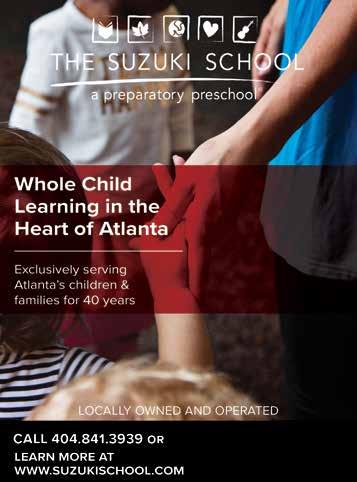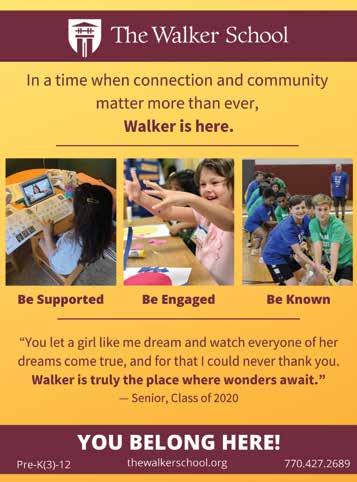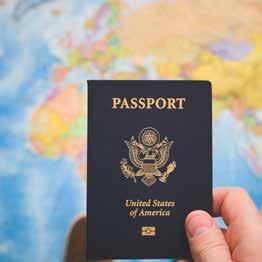
8 minute read
Neighborhood Spotlight
neighborhood SPOTLIGHT Woodstock
By Michelle Bourg
Woodstock calls itself “a city unexpected,” and this community located 30 miles northwest of Atlanta along Interstate 575 certainly offers amenities you might not imagine in a city of 32,000. Home to more than 2,500 businesses, the city also offers abundant recreation, cultural, shopping and dining options. There’s plentiful housing as well, including single-family homes, townhomes and apartments. It’s easy to see why Woodstock has been steadily racking up accolades from national media outlets and was the only Georgia city to make Money magazine’s 2015 list of “Top 50 Best Places to Live in the U.S.”
Elm Street Cultural Arts Village
PHOTO: Jillian Melko
Avery home model kitchen at Claremore Manor

PHOTO: Ashton Woods
Patio at Freight Kitchen & Tap

PHOTO: Freight Kitchen & Tap
OFF THE BEATEN PATH Woodstock offers a community bike share program for $3 per hour (with the first hour free) and up to $24 per ride, and, on weekends, a free downtown trolley service that connects points of interest every 30 minutes.
Housing
Close to both Main Street and I-575, Riverside is a pedestrian-friendly community priced from the high $300s to mid-$500s, featuring single-family homes with tennis courts, a pool, a playground and other amenities. At Claremore Manor, wooded greenspace and a playground area with a pool are the setting for designer homes with spacious floor plans. Prices range from the high $300s to high $400s.
Culinary Treats
a James Beard Foundation Award for Excel lence, Vingenzo’s serves Southern Italian fare with simple elegance. A 126-year-old house in historic downtown Woodstock is home to the Century House Tavern, which offers both small dishes and special entrees. The Freight Kitchen & Tap, housed in a former railroad freight building, offers a menu built around seasonal farm-to-table ingredients and innova tive craft cocktails. The annual Woodstock Restaurant Week, held in October, celebrates the city’s culinary offerings with special menus at downtown restaurants and discounts at gourmet shops and food stores.
Arts and Entertainment
Elm Street Cultural Arts Village is a vibrant community arts program that provides an op portunity to both participate in and enjoy live theater, music and the visual arts. It also offers classes and summer youth drama and art camps. Music lovers can enjoy concerts in Woodstock year-round, including the city’s Summer Concert Series and the Music Mondays in May lunchtime series, taking place downtown at Northside Hospital-Cherokee Amphitheater in Recipients of numerous accolades including
the Park at City Center.
Local Treasures
Woodstock is the perfect community for those who live to get outside. The Greenprints Trail System connects the city and surrounding areas with miles of paved and natural trails, including three sections for mountain bikers of all skill levels. The Park at City Center is the city’s old-fashioned downtown square, with a gazebo, benches, fountains and shade trees. For a getaway that’s close at hand, Olde Rope Mill Park offers picnic areas, trails and fishing and canoeing on the Little River. And for beaches, water sports and camping, Lake Allatoona is less than 10 miles away. N

Boat dock at Cherokee Mills Park



MOVING NEW SCHOOL

HOW TO ENSURE A SMOOTH TRANSITION
By E. Marcel Pourtout
Getting your child properly enrolled in his or her new school can be one of the most challenging and stressful parts of moving to a new city. Find ing the right school, filling out medical information, even proving U.S. citizenship can all cause anxiety for parents. Meanwhile, your children are forced to leave behind their friends, routines and surroundings and start all over in a new setting.
But whether your child is entering a new school just a few miles away or across the country, there are steps you can take to ensure a smooth transition.
IS THIS THE RIGHT SCHOOL? If your child is attending a public school, you’ll want to make sure they’re properly enrolled with the right school. The school your child will attend is determined by his or her primary residence. The Georgia Department of Education (GDOE) at gadoe.org and Atlanta Public Schools (APS) at atlantapublicschools.us provide a geographical map with a breakdown of public schools by district, county and city.
If your child is attending a charter or independent school, this is less of an issue. Since you’ve already gone through the process of apply ing to the school and getting your child enrolled, you know where he or she is going. But you’ll want to make sure you know how far your home is from the school. Some independent schools offer transporta tion to and from school for an additional fee, but yours may not.
Parents interested in homeschooling may submit a declaration of intent form online through the GDOE. Georgia’s home study law re quires homeschooling parents to provide a basic academic educational program which includes the five content areas of mathematics, English language arts, science, social studies and reading.
MEDICAL RECORDS You’ll also need to make sure your child has had their most recent eye, ear and dental exams, and obtain a certificate of immunization. Georgia law requires that parents provide a certificate of vision, hearing, dental and nutrition screening the first time a child is admitted to a public school. This certificate, Form 3300, can be found on the GDOE website.
The state law also requires all students, including foreign exchange students, to be im munized with the required vaccines at the time of their first entry in school. This also applies if a student is returning after having been absent from a Georgia public school for more than 12 months or one school year. The certificate of immunization, Form 3231, can also be found on the GDOE website.
The Fulton County Board of Health at fultoncountyboh.org and Dekalb County Board of Health at dekalbhealth.net provide listings of certified doctors and medical institutions for children examinations and form completions. For independent schools, consult the school’s administration regarding their medical exam and immunization requirements.
OTHER PAPERWORK You’ll also be required to provide proof of birth for your child, like an original or state-certified

birth certificate. Your school or school system may accept other items, such as a copy of the birth certificate ac companied by a signed affidavit; an insurance policy on the child’s life; or a valid passport, driver’s license or military ID. Check your school or school system’s website for details.
Your child will probably also be expected to have proper photo identifica tion, such as a driver’s license, passport or state-issued ID, and a Social Security number. If they don’t already have one, visit the national Social Security web site at ssa.gov to begin the process of acquiring one.
VISITING THE SCHOOL Regardless of whether your child will be attending an independent or public school, you’ll want to pay a visit to the campus and attend an ori entation to help your child get acclimated.
“Anxious kids really need orientation to the school,” says Dr. John Lochridge, a child, adult and family psychiatrist. “They may have



difficulties with things like the lockers, cafeteria and playground. The parents and students should do a full tour of everything and discuss things such as seating with the teachers.”
This applies even to middle and high school students who move to different classrooms throughout the day.
“Go to all of the classrooms, because some kids who struggle socially are passing through many people and may worry about being liked,” says Lochridge. “They may also worry about getting from one class to another without being late. Try to simulate the school day during orientation.”
Of course, this may not be possible as the GDOE and independent schools work to determine whether and how to reopen schools after closing for the coronavirus pandemic. Keep in close touch with your school’s administration and visit its website often to know about any updates pertaining to the upcoming school year.

WORK WITH YOUR CHILD Lochridge also recommends having a talk with your child to address any concerns they might have.
After spending the previous months in the summer with a less-structured schedule, they may take some time to adjust. And, of course, normal routines were upended when schools shifted to virtual classrooms during shelter-inplace orders. Setting up an established routine, with clear expectations, is a good idea.
“They’re used to a summertime sched ule, which may mean waking up later in the morning,” says Lochridge. “I believe in the parents sitting down with their children and setting up a structured situation about a week in advance of the school year. You want the chil dren waking up early and starting a morning routine—having breakfast, getting dressed and going someplace. Kids love to stay up late, so disciplining the electronics and having dinner earlier in the evening helps.”
Have a regular conversation with your child as the school year approaches and as it begins. And check in with his or her teachers as well. Showing interest and maintaining open communication will have you well on the way to helping him or her adapt to his or her new surroundings.










